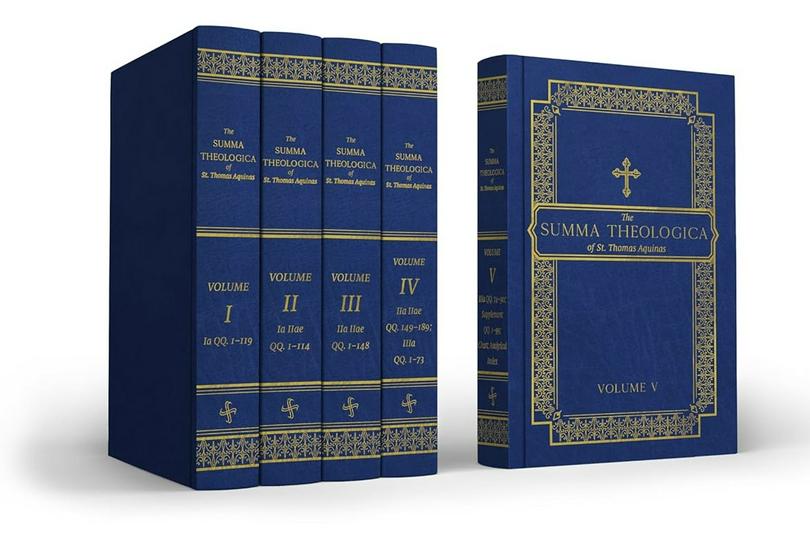In commemoration of the 800th anniversary of medieval theologian Thomas Aquinas (1225–1274), Shanghai Sanlian Publishing House has released the complete simplified Chinese translation of Summa Theologica, making one of the greatest works in Christian thought accessible to a broader Chinese readership.
According to Oak Tree Books, they have launched an exclusive pre-sale of the Collected Edition of Summa Theologica, limited to 800 sets, with delivery expected in late October. The regular edition will be released in mid-December.
This edition is published with the exclusive authorization of the Dominican Order in Taiwan and the Studium S. Pius X (Biyue Academy), which originally published the traditional Chinese edition in 2008. The traditional Chinese translation was primarily based on the Latin original and cross-checked against the English, German, French, Italian, and Spanish versions. The project was led by Dr. Zhou Keqin, former president of the Biyue Academy, and brought together five scholars in theology and philosophy—Liu Junyu, Chen Jiahua, Gao Xudong, Hu Ande, and Wang Shoushen—who collaborated on the work over a span of three decades.
Building upon the 2008 traditional Chinese edition, the new simplified Chinese version preserves the original translation while refining the editorial format and details for improved readability. The full set comprises seventeen volumes of the main text and two additional volumes—an introductory guide and a comprehensive index—to assist readers in study and reference.
Summa Theologica unfolds in the scholastic "disputed question" format, with each topic presented through the structure of "Question," "Objections," "On the contrary," "I respond that," and "Replies to the objections". Aquinas began this monumental work in 1265 as a teaching aid for his students and completed several million words (over 6.5 million in the Chinese edition) within seven years. In 1273, after a mystical experience, he abruptly ceased writing, leaving the work unfinished but creating a theological monument that continues to inspire generations.
The book is divided into three main parts: the first treats God and creation (119 questions); the second examines human action and ethics, divided into two sections—the "general ethics" (114 questions) and the "special ethics" (189 questions); the third part focuses on Christ and the sacraments (90 questions), followed by a supplement of 99 questions and two appendices. Altogether, the work contains 613 questions and 3,093 articles, systematically laying out the framework of Christian theology—"an edifice of thought," as many have called it.
Throughout the Summa Theologica, Aquinas draws extensively on Scripture, the church fathers (especially Augustine), and philosophers (especially Aristotle), integrating divine revelation with human reason in a synthesis of remarkable depth and balance.
Philosopher Peter Kreeft describes Aquinas's style as atomistic and choppy, yet his vision is continuous and all-encompassing. "St. Thomas chops his prose into bite-sized segments for the same reason Mommy cuts Baby's meat into bite-sized chunks."
Aquinas's writing background was marked by strong historical tension. In the 13th century, the rise and rapid expansion of Islam posed a significant threat to Christianity. At that time, Islamic philosophers Averroes and Avicenna developed a powerful intellectual system that achieved an extraordinary synthesis between Islam and Aristotelian philosophy. However, the "doctrine of double truth" embedded in Islamic philosophy fatally separated supernatural revelation from natural knowledge.
Against this backdrop, Aquinas composed his two monumental works—Summa Contra Gentiles and Summa Theologica—to provide a solid rational defense and systematic argument for the Christian faith. In the preface to the Summa Theologica, he wrote, "We have undertaken this work to explain matters concerning the Christian faith in a manner suited to the instruction of beginners." Thus, despite its vast scope, the Summa Theologica is written in a clear and accessible style, suitable for both scholars and ordinary readers.
In Summa Theologica, Aquinas explores not only the nature of God and creation but also the moral and existential questions of human life—happiness, virtue, and justice—offering insights that transcend religious boundaries and speak to the human condition. For more than seven centuries, the work has profoundly shaped theology, philosophy, ethics, and law, and continues to stand as a cornerstone of both scholarship and faith.












